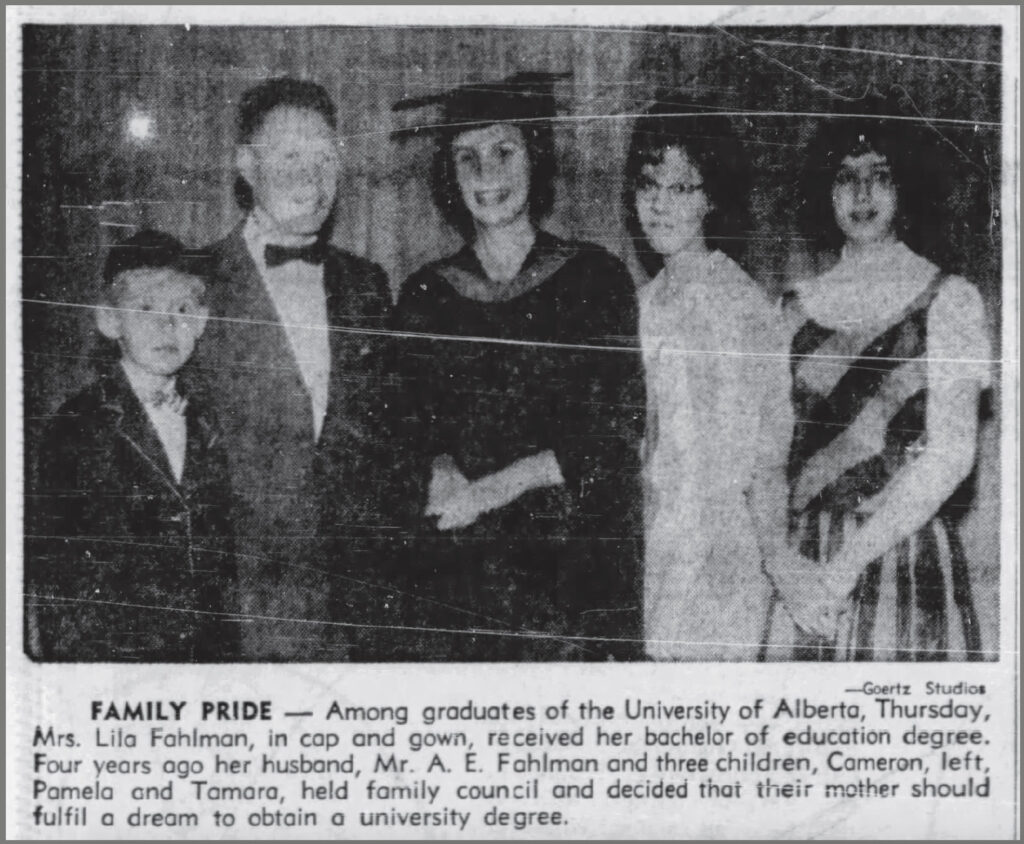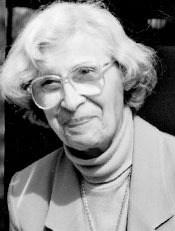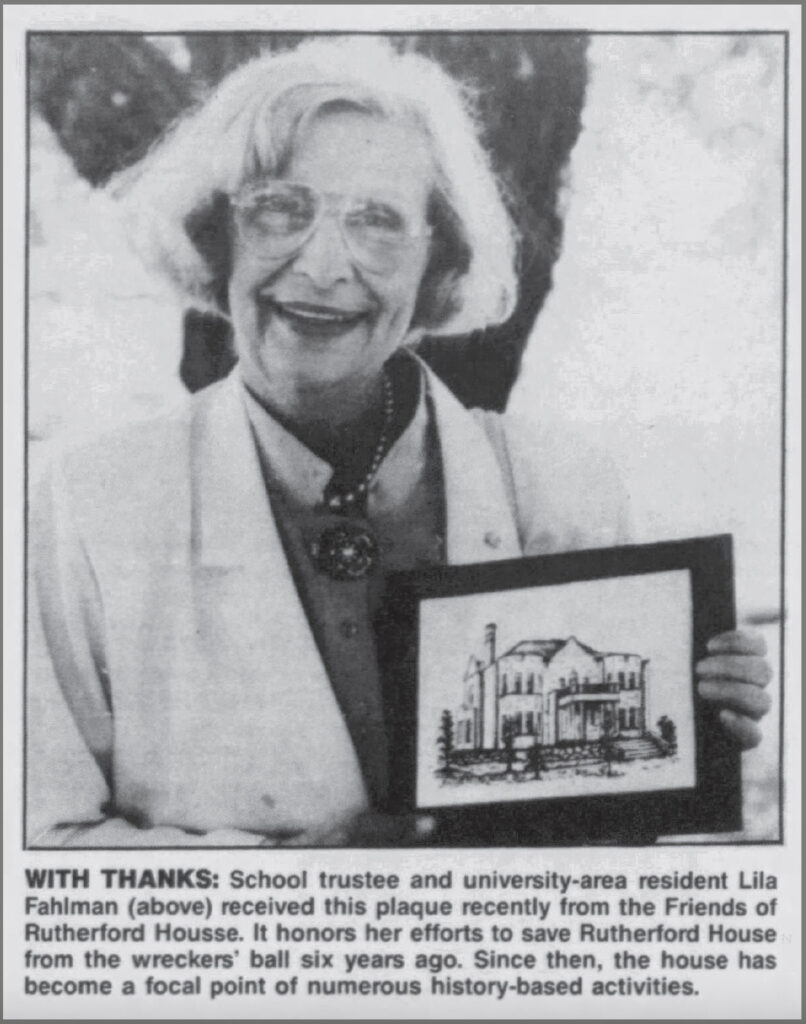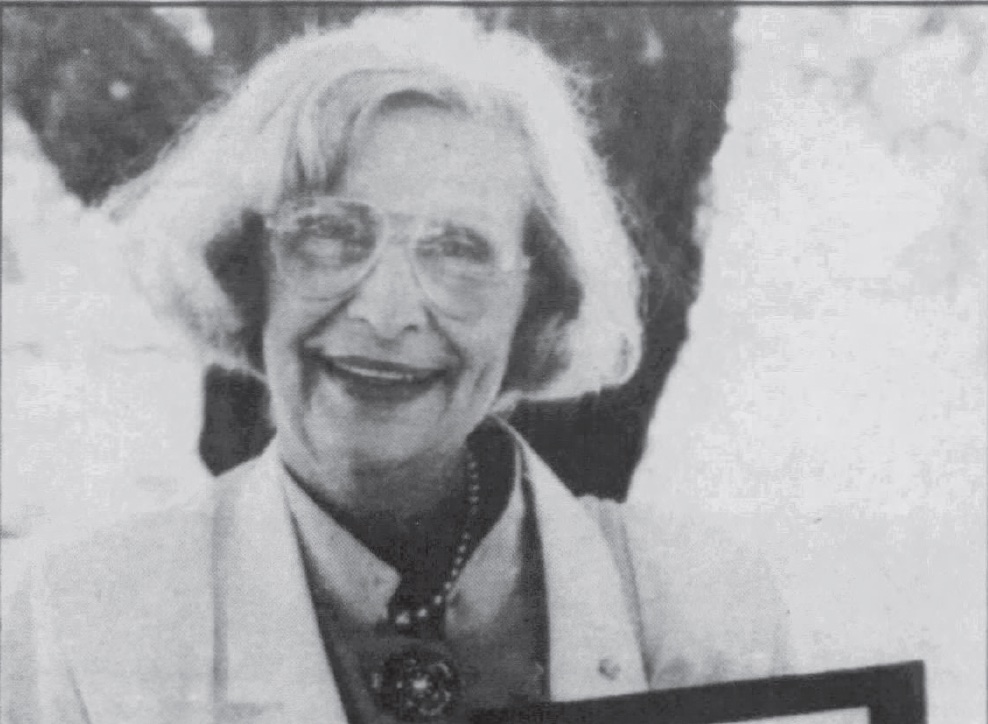Lila Fahlman’s career as an activist began with a riot. It was Canada Day 1935, and the 11-year-old Lila was attending a peaceful labour rally with her mother in Regina’s Market Square. The rally was part of the On-to-Ottawa Trek in the depths of the Great Depression, where hundreds of men rode the rails east to demand better working conditions in federal work camps.[1]
“All of a sudden, Mounties on horseback charged into the crowd,” Fahlman recalled to the Edmonton Journalin 1994. “People were hurt. Screaming. Mother grabbed me and ran. She was furious and said: `How dare they! This is not freedom. All we want is food, work!’”[2]
The Regina Riot—and more specifically, her mother’s courage—proved to be a formative experience for Fahlman.
“I’m politically minded, justice-oriented and I can’t help speaking out if someone needs help,” Fahlman told the Journal. “That’s what my mother taught me.”[3]
For the next seven decades, Lila Fahlman applied the lessons she’d learned from her mother to all that she did. She was known for her “fierce honesty and iron determination,”[4] and according to her son Cam, she “was absolutely tenacious and would not let go when she really believed in something.”[5]

Lila Fahlman with family at her graduation in 1962. Edmonton Journal, 25 May 1962.
While raising three children, she went back to university at the age of 34[6] and became a teacher, a school counsellor, and a community activist.[7] Guided by her strong faith in Islam, she focused her work on several issues: fighting violence against women,[8] promoting interfaith dialogue,[9] and providing educational opportunities for Muslim girls around the world.[10]
Her greatest passion outside of her family was advocating tirelessly for the rights of immigrant women and children.[11] She made it her mission to assist with the settlement of Muslim immigrants, particularly women, and to make space for their exploration of their traditional rights within Islam and how they could exercise them in their new homeland. “A lot of women she knew didn’t have a voice, and she wanted to give them one,” her daughter Pamela recalled.[12]
To that end, in 1982 she founded the Canadian Council for Muslim Women (CCMW).[13] She conceived of the idea while attending a Canadian Islamic men’s council, where “she used her own persuasive powers to get them to jet her around the country to talk to Muslim women and form a council of their own.”[14]
In its first year, CCMW focused on educating its new members. “Sometimes the women weren’t that knowledgeable about their faith, so we often looked into the Koran[15],” said Fahlman.[16] Within a decade, more than a thousand Canadian women had joined the council.[17] Its mandate grew from education to also include research, publications, coordinating legal resources, public policy advocacy to governments, anti-racism initiatives to counter Islamophobia, and much more.[18]

Eventually, the CCMW became so successful that, according to Fahlman, “the organization practically [ran] itself.”[19] So in 1992, she focused her energy on a new project, founding the World Council of Muslim Women Foundation to help promote education for Muslim girls both in Canada and abroad.[20]
Image accessed here: https://cfc-swc.gc.ca/commemoration/woi-fic/lila-fahlman-en.html
Fahlman was proud of her faith in Islam and the work that she did to help Muslim women and girls. But she was also a “passionate advocate of interfaith dialogue” [21] who travelled the world helping to build a network of respectful, intercultural exchange between different religious groups. She fully practised what she preached, developing close friendships with people of other faiths. During an interview with the Edmonton Journal about her interfaith activism, she received a phone call from a Jehovah’s Witness friend to schedule a meet-up. “When we get together and talk, I learn and she learns,” Fahlman explained. “You can’t have peace in the world otherwise.”[22]
This firm conviction led her to serve as the vice-chairwoman of Vision TV, head of the World Interfaith Education Association, and co-founder of the Edmonton Interfaith Centre.[23] She organized Edmonton’s first Interfaith Festival and was particularly pleased to have Indigenous groups participate.[24] “When people talk on a very personal level about something that’s important to them, it promotes mutual respect and understanding, and that’s what our goal is,” she said of the festival.[25]
As if she didn’t have enough on her plate with her multitude of interfaith activities, Fahlman also found time to save some of Edmonton’s architectural treasures from the wrecking ball. Her father Sied Ganam, a Syrian-Lebanese immigrant, had helped build Edmonton’s original Al-Rashid mosque (the first mosque in Canada),[26] and a generation later Fahlman helped save it and have it relocated to its current home at Fort Edmonton Park.[27]
As president of the Society for the Preservation of Historic Homes, she also led the charge to save Rutherford House from demolition, arguing that the provincial government and University of Alberta administration were greatly exaggerating the estimated costs of restoration. “My feeling is our politicians here have very little foresight… What are we going to show our people in Alberta’s Centennial? You can’t reclaim history.”[28]

Lila Fahlman with a drawing of Rutherford House. Edmonton Journal, 18 June 1989.
A long-time resident of the Garneau neighbourhood, Fahlman’s own home was eventually expropriated and demolished by the University—but there is still a maple tree on campus near the Humanities Building that was originally planted by her husband. “As a family whose roots are in Garneau where our three children and I attended University, we feel trees have always been a vital part of living in Garneau,” Fahlman wrote in a letter to the university administration. “I trust you will permit the Fahlman family this opportunity to contribute to the history of ‘old Garneau.’” [29]
Dr. Lila Fahlman, of course, contributed more than just a single tree, and to more than just a single neighbourhood. “A proud feminist, a proud Muslim, and a proud Edmontonian,”[30] Fahlman achieved many firsts in her life. She was the first woman in Canada to obtain a PhD in Educational Psychology and the first Muslim woman in Canada to serve on a public school board. She was the first Muslim woman in North America to serve as a university chaplain and, in 2001, she became the first Muslim woman awarded the Order of Canada.[31]

The Fahlman Tree as pictured in the University of Alberta’s “A Century of Campus Maps” by Ellen Schoeck. Accessed here: https://www.uap.ualberta.ca/book-images/Open%20Access/9781551953823.pdf
But in many ways, the tree is the perfect symbol of Fahlman’s life and legacy—standing strong in her convictions; refusing to be moved by any outside pressures; providing peaceful shade and comfort to anyone who needs it, regardless of their faith or background. Right before her family home was expropriated, self-described tree-lover Lila told the Journal that when the Fahlmans were forced to leave Garneau, “they’ll look for another home where there’s the kindliness of trees.”[32] Lila herself embodied that same kindliness, that same resolute, calm wisdom of the trees. “Her determination came with a large dose of compassion.”[33] Her career as an activist began with a riot, and she left the world more peaceful and harmonious than she had found it.
Bruce Cinnamon © 2021

[1] “On to Ottawa Trek.” Victor Howard, Ed. Daniel Panneton. The Canadian Encyclopedia. 7 February 2006, updated 26 July 2016. Accessed 25 January 2021. https://www.thecanadianencyclopedia.ca/en/article/on-to-ottawa-trek
[2] “Mothers & Daughters.” Lasha Morningstar, Journal Life Writer. The Edmonton Journal. 08 May 1994: F1.
[3] “Mothers & Daughters.” Lasha Morningstar, Journal Life Writer. The Edmonton Journal. 08 May 1994: F1.
[4] “Lifelong educator was a champion for the rights of immigrant women and children.” David Finlayson. The Edmonton Journal, 16 May 2006: B3.
[5] “Lifelong educator was a champion for the rights of immigrant women and children.” David Finlayson. The Edmonton Journal, 16 May 2006: B3.
[6] “Family shares her career.” The Edmonton Journal. 14 May 1980: Page 28.
[7] “Lila Fahlman.” Status of Women Canada. Accessed 25 January 2021. https://cfc-swc.gc.ca/commemoration/woi-fic/lila-fahlman-en.html
[8] “About Our School – Dr. Lila Fahlman.” Edmonton Public Schools. Accessed 25 January 2021. https://lilafahlman.epsb.ca/aboutourschool/schoolprofile/
[9] “Interfaith festival; Celebration of religious tolerance focuses on family ties.” Dave Finlayson. The Edmonton Journal, 17 February 1996: H4.
[10] “Order of Canada to Fahlman: Life of activism began with a bang at 1935 Regina Riot” Hanneke Brooymans. The Edmonton Journal, 2 September 2001: B1.
[11] “Lifelong educator was a champion for the rights of immigrant women and children.” David Finlayson. The Edmonton Journal, 16 May 2006: B3.
[12] “Lifelong educator was a champion for the rights of immigrant women and children.” David Finlayson. The Edmonton Journal, 16 May 2006: B3.
[13] “Our Story – Her Story, From the Beginning.” Canadian Council of Muslim Women. Accessed 25 January 2021. https://www.ccmw.com/our-story
[14] “Order of Canada to Fahlman: Life of activism began with a bang at 1935 Regina Riot” Hanneke Brooymans. The Edmonton Journal, 2 September 2001: B1.
[15] Please note that “Qur’an” is the proper transliteration of the original Arabic term. The outdated spelling is primarily used by Orientalist scholars, and is included here as it appeared in the original source.
[16] “Order of Canada to Fahlman: Life of activism began with a bang at 1935 Regina Riot” Hanneke Brooymans. The Edmonton Journal, 2 September 2001: B1.
[17] “Canadian Muslims demonstrate faith.” The Hamilton Spectator, 7 March 1992: D7.
[18] Canadian Council of Muslim Women. Accessed 25 January 2021. https://www.ccmw.com/
[19] “Order of Canada to Fahlman: Life of activism began with a bang at 1935 Regina Riot” Hanneke Brooymans. The Edmonton Journal, 2 September 2001: B1.
[20] “Order of Canada to Fahlman: Life of activism began with a bang at 1935 Regina Riot” Hanneke Brooymans. The Edmonton Journal, 2 September 2001: B1.
[21] “In honouring strong Muslim women, Edmonton school names send powerful message.” Paula Simons, The Edmonton Journal, 23 June 2016. Accessed 25 January 2021. https://edmontonjournal.com/news/local-news/paula-simons-in-honouring-strong-muslim-women-edmonton-school-names-send-powerful-message
[22] “Order of Canada to Fahlman: Life of activism began with a bang at 1935 Regina Riot” Hanneke Brooymans. The Edmonton Journal, 2 September 2001: B1.
[23] In honouring strong Muslim women, Edmonton school names send powerful message.” Paula Simons, The Edmonton Journal, 23 June 2016. Accessed 25 January 2021. https://edmontonjournal.com/news/local-news/paula-simons-in-honouring-strong-muslim-women-edmonton-school-names-send-powerful-message
[24] “Interfaith festival; Celebration of religious tolerance focuses on family ties.” Dave Finlayson. The Edmonton Journal, 17 February 1996: H4.
[25] “Interfaith festival; Celebration of religious tolerance focuses on family ties.” Dave Finlayson. The Edmonton Journal, 17 February 1996: H4.
[26] “In honouring strong Muslim women, Edmonton school names send powerful message.” Paula Simons, The Edmonton Journal, 23 June 2016. Accessed 25 January 2021. https://edmontonjournal.com/news/local-news/paula-simons-in-honouring-strong-muslim-women-edmonton-school-names-send-powerful-message
[27] “Lifelong educator was a champion for the rights of immigrant women and children.” David Finlayson. The Edmonton Journal, 16 May 2006: B3.
[28] “Rutherford House Demolition To Be Queried By Lougheed.” The Edmonton Journal, 7 October 1967: Page 3.
[29] “A Century of Campus Maps.” Ellen Schoeck. University of Alberta, 2007. Page 19. Accessed 25 January 2021. https://www.uap.ualberta.ca/book-images/Open%20Access/9781551953823.pdf
[30] “In honouring strong Muslim women, Edmonton school names send powerful message.” Paula Simons, The Edmonton Journal, 23 June 2016. Accessed 25 January 2021. https://edmontonjournal.com/news/local-news/paula-simons-in-honouring-strong-muslim-women-edmonton-school-names-send-powerful-message
[31] “Lila Fahlman.” Status of Women Canada. Accessed 25 January 2021. https://cfc-swc.gc.ca/commemoration/woi-fic/lila-fahlman-en.html
[32] “Ear to the Grass Roots.” Ruth Bowen, Women’s Editor. The Edmonton Journal, 11 October 1966. Page. 21
[33] “Lifelong educator was a champion for the rights of immigrant women and children.” David Finlayson. The Edmonton Journal, 16 May 2006: B3.

